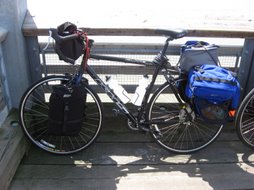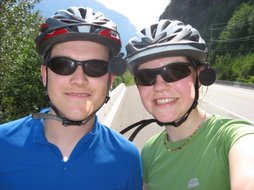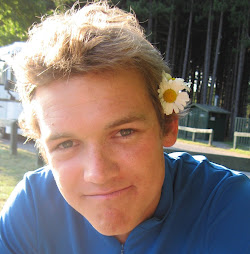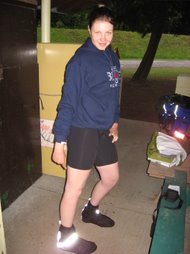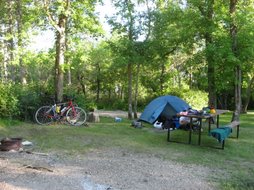By Agnes Bolinska and Joseph D. Martin
The sun had bowed down behind the hills of the Lake District by the time we rolled into Kendal. It was a cool and gusty 8:30 and we had yet to figure out our sleeping arrangements. No worries, we thought, Kendal’s a sizable place—let’s call up a few hotels. Riverside Hotel: full. County Hotel: no vacancies. Premier Inn: jammed. Kendal Camping and Caravanning Club Site: no pitches. It was, it dawned on us as dusk settled in, bank holiday weekend. The city at the gateway to the Lake District and the Yorkshire Dales was booked solid. For the first time in a week, we began to think that we should have spent more than 36 hours throwing together a plan to cycle Great Britain top to bottom.
We began to plod sullenly toward the nearest pub, hoping to glean some local knowledge that might lead us to a suitable campsite, when Agnes spotted a couple walking their dog coming toward us. “Hi!” she said, and explained our predicament, asking them if they knew of a place where we could pitch a tent. “Why, you’d be welcome to pitch up in our back garden,” came the reply. Salvation! We wrapped up our first week on the road eating chocolate and drinking whisky snug in our tent thanks to the kindness of strangers.
 This tour had begun much like Agnes’s first tour across Canada twelve years ago: on a bit of a whim, and without an excess of preparation. But there were differences in magnitude. In 2007, Agnes had no idea what it meant to go on a cycle tour, and so had to buy a bike and all of the requisite touring kit. In 2019, she is a seasoned vet. And so, when Agnes and Joe decided they would like to do John O’Groats to Land’s End (“JOGLE”)—the British equivalent of cycling across Canada—on a Friday, it was possible for them to throw everything together and start the following Monday.
This tour had begun much like Agnes’s first tour across Canada twelve years ago: on a bit of a whim, and without an excess of preparation. But there were differences in magnitude. In 2007, Agnes had no idea what it meant to go on a cycle tour, and so had to buy a bike and all of the requisite touring kit. In 2019, she is a seasoned vet. And so, when Agnes and Joe decided they would like to do John O’Groats to Land’s End (“JOGLE”)—the British equivalent of cycling across Canada—on a Friday, it was possible for them to throw everything together and start the following Monday.This tour was, of course, much shorter: a mere 1,542 km according to Google’s cycling directions, rather than the 6,764 km Agnes and Dan cycled in 2007. And the circumstances had changed significantly. Then, at 23, Agnes had just finished her first year as a grad student and was taking the summer off before spending a year living and working in the UK. There was no real time limit on that tour, so Agnes and Dan could take all the breaks and days off they needed. Now, Agnes and Joe both have jobs and responsibilities—albeit ones that come with a great deal of flexibility and freedom—and Agnes had a deadline, so we had only thirteen days in which to complete JOGLE. It would be tight, but manageable.
Having resolved on Friday to JOGLE, we threw our kit in our panniers, bought a few essentials, and Agnes hopped on a train to Durham. On Sunday, we crammed our bikes in the back of a rented SUV and drove to Wick, the nearest town to John O’Groats with a car hire place, stopping for a very Scottish lunch at House of Bruar, a sprawling country store at the south of the Cairngorms. There, after filling up on steak and ale pie and grilled veggies, we resisted the temptation to browse the wide selection of tweeds and pressed on. Arriving into Wick got us within 26 km of John O’Groats, making for a perfect Day 0 warmup ride to the glamping pod where we spent our first night. We felt ourselves on top of the world.
We needed those high spirits to brave our first day on the road, where they would be battered by stiff headwinds and driving rain. The north coast of Scotland is stunningly rugged—which is a fancy way of saying that it’s hilly. The wind and rain and hills make for slow going (as does the three weeks of comparative lethargy Joe is still shaking off.) But we’re doing it—we’re on the cycle tour!—and that makes us happy. We both needed this after several weeks of conference travel and solitary research.
* * *
 |
| Allons-y! |
 |
| Scotland: land of terrain |
And the hills! In Canada, most often you could use your momentum to go at least part of the way up the next hill from the previous downhill. Here, a downhill would often end at a T-junction, meaning you’d have to stop, and then start again uphill. And the narrowness and windiness of the roads—together with the lack of visibility around those hedges—meant that we’d often be braking for dear life down those hills anyway. This resulted in some quite inefficient riding, making it next to impossible to cover the kinds of daily distances Agnes and Dan did in 2007.
 |
| Some of the worthwhilest scenery |
 |
| The odd castle |
* * *
One of the most endearing features of cycle touring is that riding away from the main roads and skirting the tourist attractions creates ample opportunities to interact with the people living in a place as they go about their day-to-day lives. Some of these encounters happen by chance, as with Jane and Fred, the Kendal couple who graciously invited us to camp on their lawn. Those are the best kinds of encounters.
 On Day 9 we’d made the decision to cut west, a slightly longer, slightly hillier route that would take us toward the picturesque Shropshire Hills and avoid the flatter but visually unremarkable Birmingham suburbs. We were barrelling along a lonely country road in Shropshire when a couple we passed waved enthusiastically and asked where we were heading. “Land’s End!” we cried while riding past. “Oh!” they replied, “Do you fancy a cup of tea?” How could we say no?
On Day 9 we’d made the decision to cut west, a slightly longer, slightly hillier route that would take us toward the picturesque Shropshire Hills and avoid the flatter but visually unremarkable Birmingham suburbs. We were barrelling along a lonely country road in Shropshire when a couple we passed waved enthusiastically and asked where we were heading. “Land’s End!” we cried while riding past. “Oh!” they replied, “Do you fancy a cup of tea?” How could we say no?Rachel and Charles invited us into their home—a lovely converted farmhouse—and treated us to tea and biscuits. Charles was an avid cyclist and eager to hear stories of our trip, while also dishing out some fantastic advice for our route south.
We also stayed with a number of Warm Showers hosts, each of whom graciously welcomed us into their homes, offering us not only the obligatory (and always very welcome) warm shower, but also a place to dry wet stuff, a cosy bed, and hot meals over which to swap cycling stories. Linda, our first Warm Showers host just outside Edinburgh, had, like Agnes, started her foray into cycle touring by riding across North America west to east. It turns out that Linda and Agnes started those tours from the same place, possibly even on the same day (June 1st, 2007)!
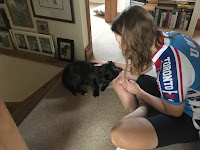 |
| Agnes and Lola |
Ben, our final Warm Showers host in Beachley, just across the Severn from Bristol, was a seasoned cyclist (we think we spotted seven bikes, including a unicycle!), but a relatively new cycle tourer. He brought that fresh enthusiasm to his hosting. Not only did Ben know his way around a cod fillet, he was also a gifted storyteller, and his tales from the road had us in stitches. Particularly amusing was his encounter with a French girl in a sundress touring on a step-through cruiser, who’d been on the road for days, maybe weeks. She’d managed to collect in her wake a fully kitted out road biker who’d by that point come only about 10 miles—appearances aren’t everything!
* * *
Halfway through our day-four push into the Edinburgh suburbs, our bodies started to fall apart. Agnes’s knee was screaming after our hard trek through hilly terrain. Joe’s Achilles tendons protested his poorly adjusted saddle. After pressing through the pain and the rain and literally limping into Linda’s house in Dumferline, we were certain that a day off was in order.
 |
| Cycle path to joint pain |
The comparatively sedate day restored us, and we were able to press in southward without being dogged by pain at every pedal stroke. Our next need for a break came just past Bristol. Our Warm Showers stop in Beachley, just across the Severn from Bristol, was preceded by some of the fiercest and longest climbs of the trip. The next day, we managed to make it across the Severn Bridge and pick our way through the Bristol suburbs, but Agnes’s knee injury had flared up again. We resolved to stop at an inn in Tickenham and stroll into Clevedon, on the Somerset coast.
 |
| Clevedon |
 |
| "More weight, please," says the Surly |
We ended our JOGLE bid early, stopping in Yatton to drink coffee, commiserate, and plan our transportation back to Cambridge and Durham. It was a sad moment, but we took comfort both in what we did accomplish and in our resolve that the journey is…
to be continued…




















